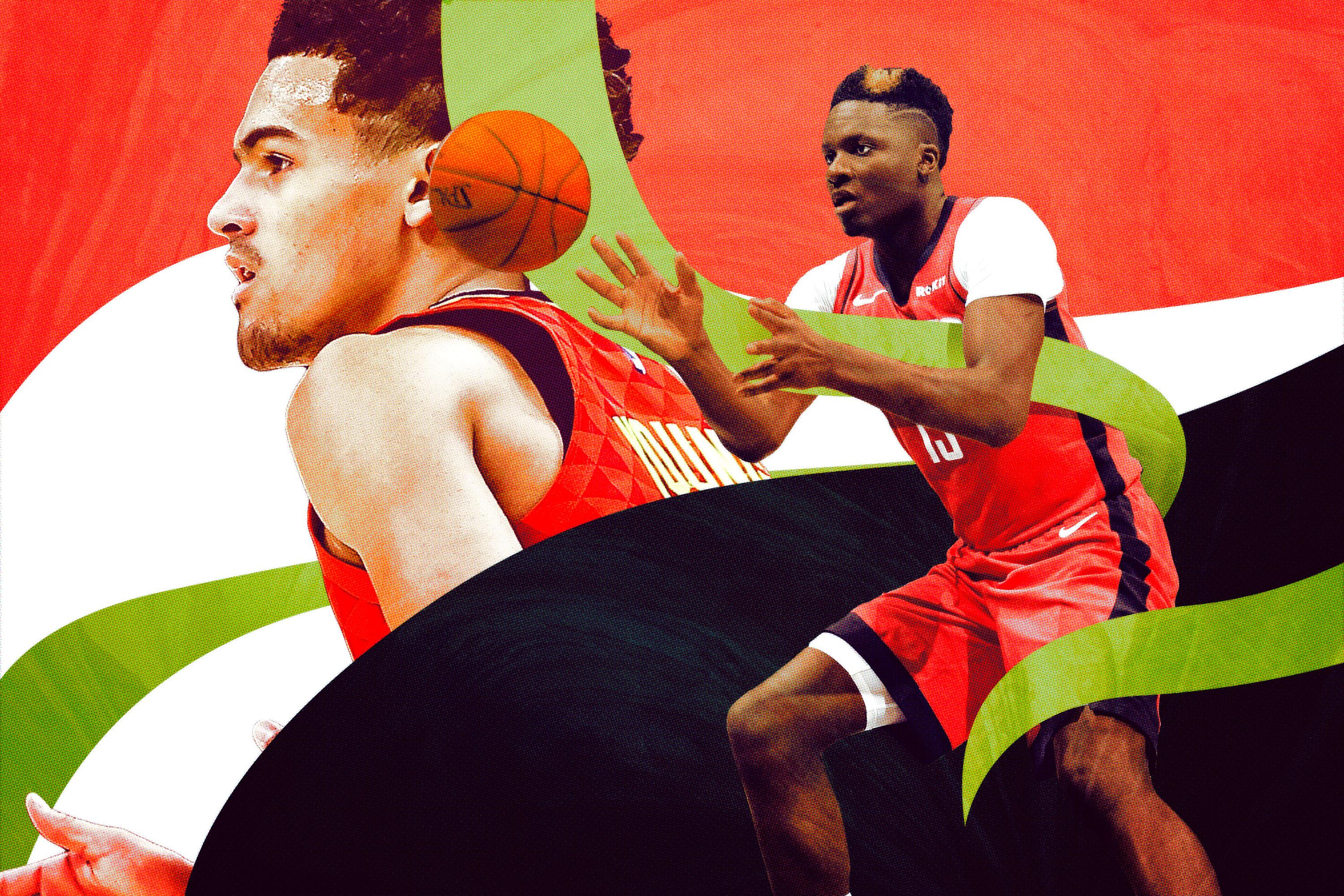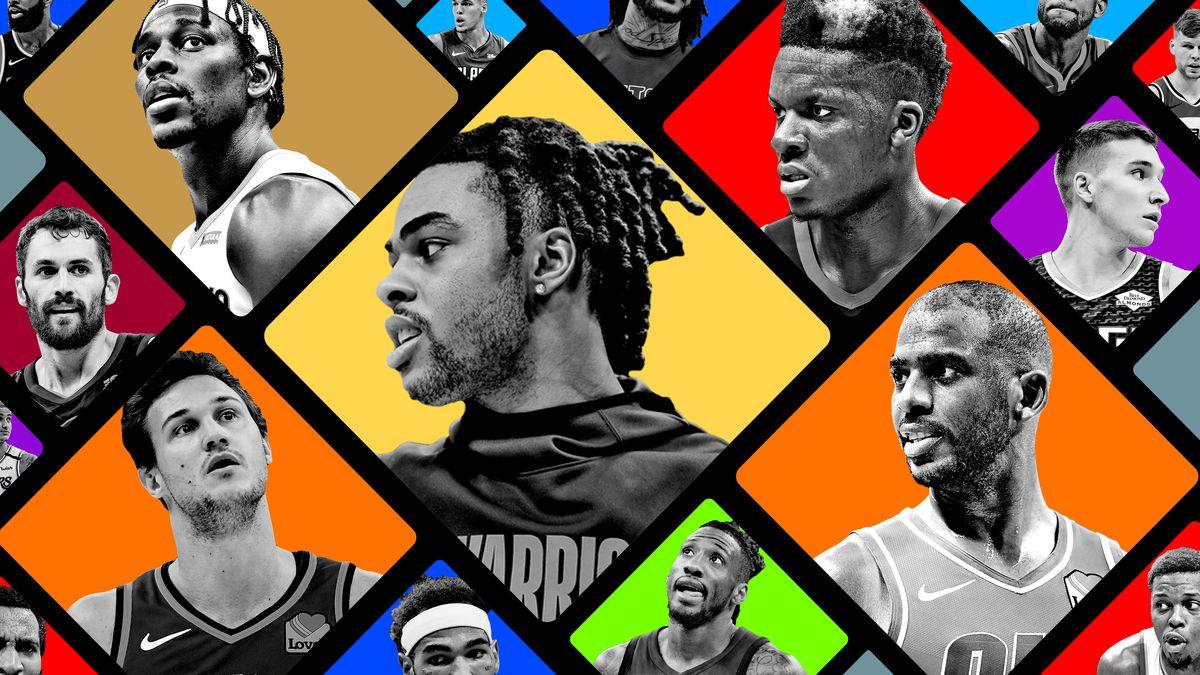
Trae Young has been looking for more help on his frustrated and frustrating Hawks for about two months, and Atlanta general manager Travis Schlenk finally found some for him. Bringing Clint Capela into the fold to screen, dive, dunk, and swat could mean the expected completion date of the Hawks’ slow-and-steady rebuilding project is about to move up slightly. It also raises some questions about whether a team that’s been building very intentionally for the past two and a half years is still cool with sticking to the same blueprint.
The Hawks, Rockets, Timberwolves, and Nuggets formed like Voltron late Tuesday night to consummate a monster four-team, 12-player deal—the largest trade the NBA has seen in nearly 20 years—that signaled the start of the sprint to the league’s Thursday 3 p.m. ET trade deadline. The deal landed a lot of faces in new places, with Atlanta coming away with Capela—a spring-heeled 25-year-old rim runner and rim protector who, in keeping with Schlenk’s philosophy of assembling carefully curated pieces to surround Young, seems like a hand-in-glove fit for the Hawks’ needs.
Atlanta ranks fourth in the league in the share of its offensive possessions finished by both ball handlers and roll men in the pick-and-roll. Enter Capela, whose usage in the screen game has diminished in recent years as Houston has pivoted to a more isolation-heavy attack, but who remains an attention-demanding target that defenses have to account for, and who’s shooting 68 percent at the rim. He was far and away James Harden’s favorite target for lobs, pocket passes, dump-offs, and dimes during his tenure in Houston; one imagines him quickly developing a productive partnership with a similarly inventive creator in Young, who was just named an All-Star starter. (Also, as NBA.com’s John Schuhmann notes, Capela has finished more possessions as an off-ball cutter/pseudo screener than anybody in the league, so it’s not as if he’s been totally defanged as a vertical spacer as the Rockets rode iso-ball into a new dimension.)
As central as Capela figures to be as a pick-and-roll hub, his impact might be felt even more acutely on the defensive end, where the Hawks have been dreadful all season, ranking 27th in points allowed per possession. Again: enter Capela. The Rockets allowed 2.8 fewer points per 100 non-garbage-time possessions with Capela on the floor than when he sat, according to Cleaning the Glass—roughly the difference between a top-10 defense and a bottom-10 unit. Atlanta currently concedes shots at the rim more frequently than any team besides the Bulls, and while Capela hasn’t been an elite paint protector this season—he ranks 38th out of 70 players defending at least four attempts at the rim per game—Rockets opponents did take up-close shots less frequently, and convert them less successfully, with Capela on the floor. The same holds true on the boards: Houston pulled down 73.4 percent of opponents’ misses with Capela on the court, a defensive rebounding rate that would rank 10th over the whole season, and just 70.8 percent with him off the floor, which would rank a dismal 28th … a tick behind the 27th-place Hawks’ full-campaign mark.
Dropping Capela into Atlanta’s ecosystem, then, should help amplify Atlanta’s primary strength (the pick-and-roll playmaking of Young and the potency of the offense it generates) and address its main weakness; namely, the persistent inability to stop anyone from getting free layups on them. (When Capela is healthy enough to play, that is; he missed four of the Rockets’ last five games before the trade with a right heel injury that The Athletic’s Kelly Iko reported “doesn’t sound like is a day-to-day situation,” and could keep him out “until after the All-Star break.”) Young’s size and defensive failings were always going to be a challenge for Schlenk when it comes to roster construction. The best way to neutralize Young’s weaknesses is to surround the franchise point guard with large, long-limbed athletes to help keep him out of trouble and erase any mistakes at the point of attack. Lineups featuring some combination of Capela, John Collins, De’Andre Hunter, Cam Reddish, and Kevin Huerter—all between 6-foot-7 and 6-foot-11, with positive wingspans and quick feet—could give Atlanta a puncher’s chance at doing so. And, importantly, doing so at a manageable price.
The Hawks had previously been linked to Andre Drummond, another screen-and-dive big man and a historically prolific rebounder who would profile as a paint-patrolling partner for Young in the two-man game. But the 26-year-old former All-Star has a player option for next season that he is all but certain to exercise, meaning that any team trading for him would have to be cool with ponying up a certainly lucrative new deal to keep him around. Capela, on the other hand, is under contract through the end of 2022-23. Reasonable people can disagree, but it seems significantly better for Atlanta’s bottom line to be on the hook to pay Capela $51.3 million for the next three seasons than to pay Drummond—whose statistical output has often seemed to outstrip his on-court impact for the Pistons—more than $100 million over the next four. It also should help as the other young pieces of the Hawks’ core move closer to becoming eligible for extensions.
The Capela trade figures to affect one of those core pieces more than the others: Collins, whom Atlanta snared with the 19th pick in the 2017 draft, and who has quickly become one of the most productive young big men in the league.
According to Basketball-Reference.com, only 11 players have averaged better than 19 points, 10 rebounds, and 1.5 blocks per game by their age-22 seasons. Five (Bob McAdoo, Hakeem Olajuwon, Charles Barkley, Alonzo Mourning, Shaquille O’Neal) are already in the Hall of Fame. Two (Tim Duncan, Kevin Garnett) are about to be; two more (Dwight Howard, Anthony Davis) are perhaps on pace to join them. The 10th was Elton Brand, a no. 1 overall pick who was an absolute monster before tearing his Achilles tendon. The 11th is Collins, who becomes extension-eligible this summer. ESPN’s Zach Lowe reported earlier this week that several teams had inquired about Collins’s availability, “thinking the Hawks might be worried about extension talks” in which Collins’s reps will likely ask for something approaching the max, if not the full boat.
Collins has racked up a lot of those gaudy numbers while acting as Young’s primary pick-and-roll partner and lob threat. Young-to-Collins was the league’s eighth-most-frequent assist combination last season, according to pbpstats.com; they’re tied for 30th this season, and that’s with Collins missing nearly two months while serving a 25-game suspension. The 6-foot-9 235-pounder has taken steps forward as a defender, too, grabbing defensive rebounds and blocking shots at career-high rates. The Hawks have also allowed 4.4 fewer points-per-100 in his minutes.
Those minutes have been evenly split between playing as a power forward and a small-ball 5, though, and perhaps the biggest question surrounding Capela’s arrival is whether the two athletic bigs can coexist and elevate the Hawks together. Given the lack of stretch in Capela’s game—he has attempted two 3-pointers in six NBA seasons—that’ll likely depend on how effectively Collins can expand his game toward the perimeter.
He’s made strides in that area, attempting a career-high 3.6 3-pointers per game and hitting them at a respectable 35.6 percent clip. He’s shown some comfort from the short corners, going 42-for-101 (41.6 percent) in his young career; if he can build on that, becoming a viable knockdown threat when Capela is in the game while using his athleticism to chase around stretch 4s on the other end, Atlanta could have the makings of a dynamic young two-way pairing to build around. (The Hawks are set to have a league-high $58.6 million in cap space this summer—more than enough to allow them to re-up Collins and still remain lean for the future.) If Collins’s development in that direction stalls, though, and his best role continues to be as a primary screener and dive man, the Hawks will have to think long and hard about how much they want to invest in him come the summer—and, if he fields an offer sheet that stretches beyond their willingness, if they can identify sign-and-trade opportunities that would allow Schlenk to find some more pieces that might fit more snugly into the puzzle he’s trying to put together.
At 13-38, the Hawks likely aren’t about to ride the momentum of this move to a post-All-Star push for the postseason; FiveThirtyEight gives them a 3 percent chance of climbing to the eighth spot in the East, and even that seems generous. But by swinging the deal for Capela now, rather than waiting to go after a big in free agency or via trade this summer, Schlenk essentially gave head coach Lloyd Pierce a two-month test drive: take a look at how Capela and Collins fit, what kind of chemistry Capela can develop with Young, and how the wings react to playing in front of a more stabilizing presence on the back line.
The hope is that Capela will hit the ground running; that Collins will become a viable spread 4 who can pivot back to the 5 when Clint sits, ensuring that Atlanta always has a high-end rim-running finisher on the court; that Young remains the straw that stirs the drink; and that Atlanta nudges north toward mediocrity rather than despair, restoring some of the positive vibes that cropped up late last season and led many of us (present company included) to wonder whether the precocious Hawks might be ahead of schedule. If all doesn’t go according to plan, though, we might start wondering something else: how long Young, now a bona fide All-Star, will be content with not getting the kind of help he feels he needs, and how long Pierce, Schlenk, and the rest of Atlanta’s brain trust will have to get it for him.
